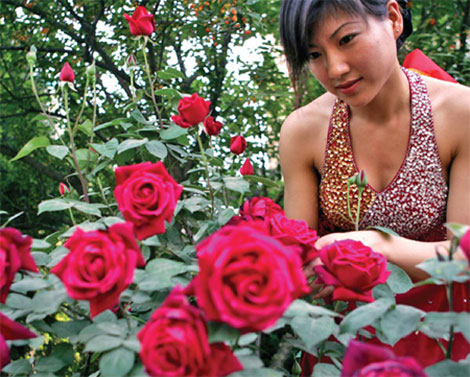War of the roses
Updated: 2011-05-06 11:06
By Liu Lu (China Daily European Weekly)
 |
|
For more than 200 years, the Chinese rose helped European growers improve the color and scent of their domestic roses. Chen Gengsheng / for China Daily |
European Chinese rose growers are beating their Chinese rivals at their own game
The renowned Chinese poet Su Shi of the Song Dynasty (960-1279) uses his famous verse to eulogize the perpetual bloom of Chinese rose: "Only the Chinese rose is unwearied. It blossoms throughout four seasons."
Like Su, many Chinese poets from different historical times were fascinated by the captivating fragrance of this plant and etched numerous lines praising its beauty and noble character.
As the name suggests, the Chinese rose originated in China, the place where it has grown for more than 2,000 years. Because of its nature to bloom frequently throughout the year, the flower has been long regarded as an auspicious symbol of long lasting value.
Today the famous flower remains popular and is the most widely cultivated ornamental flower in gardens across China.
Statistics from the China Rose Society show that there are 53 Chinese cities, including Beijing, which have named the Chinese rose as their city flower, revealing a special national affection for this adored plant.
However, despite the flower's Chinese origin and its prevalent popularity in the Middle Kingdom, Chinese botanical experts and flower merchants are becoming increasingly worried that China, the flower's birthplace, has lost face to Europe when it comes to cultivating quality roses.
Chinese growers feel their efforts have been overshadowed by their European rivals.
"Europe has become the world leader in cultivating Chinese roses," says China Rose Society vice-president Meng Qinghai, who has studied Chinese roses for 30 years.
"Many European countries, such as France, the Netherlands and Germany, have surpassed China for many years in planting and breeding techniques of Chinese rose."
He says the Chinese roses from Europe have dominated the international flower market over the past few decades, forcing more Chinese cultivators to take research trips to learn advanced cultivation skills from their European counterparts.
Meng says all the roses grown in Europe have a Chinese gene.
"The traditional Chinese rose species is the ancestor of almost all the modern cultivated hybrid roses worldwide," Meng says.
In 1780, after the Chinese rose was introduced from China to Europe, this sweet-scented flower soon won favor across all social groups: from royal families down to the common households, earning itself the title of "queen of all flowers".
Many European countries have named the rose as their national flower, including Bulgaria, Luxembourg, Romania, and England.
In order to produce more attractive flowers, European cultivators asserted tremendous efforts to improve cultivation measures.
Crossbreeding with imported Chinese roses brought major improvements in quality by endowing several distinct traits that had been lacking in European roses of the 18th century.
"The Chinese gene has helped the indigenous European species to achieve repeat blooming, petal colors of deep crimson and yellow that does not fade with age," Meng says.
"And most important of all, those scentless flowers started to give off a delicate fragrance."
He says the arrival of the Chinese rose caused great revolution in European rose gardens.
After two centuries of development, rose breeding has already reached a high standard and become a mature industry in Europe, with many century-old, family-owned enterprises becoming the pillars of the business.
Meng says although China is the flower's birth place, the industry started late in China, resulting in the ever-widening gap between China and Europe in regards to quality, breeding and cultivation technology as well as the degree of mechanized planting.
"There are currently 23,000 types of modern Chinese roses worldwide, of which only some 300 kinds are cultivated by Chinese."
Chinese growers say they are frustrated by the situation and are now learning advanced breeding skills and implementing business models from their peers in Europe.
Yang Yuyong, a grower in Southwest China's Yunnan province, is one of these businessmen.
Yang has grown the flower for 29 years but admits he cannot compete with growers in Europe.
"In Europe, the competition among rose enterprises is in fact the contest of the production of new varieties," Yang says.
"European enterprises will invest a lot of manpower and funds for research and development of new flowers."
"Although the cultivation is a long process, it does not deter their enthusiasm."
Yang says the new products bring in huge economic benefits.
He says European laws regarding intellectual property also protected the interests of cultivators.
"Once unauthorized propagation was found, the grower will face severe punishment, such as heavy fines," Yang says.
"Therefore, only large and law-abiding plantation companies can survive in Europe."
Since 1990, Yang has introduced new varieties from Europe to expand his seeds pool and has cultivated more than 600 varieties.
At the same time, he has also spent big on European machinery, which has helped him greatly improve production efficiency as well as save on labor costs.
Local governments also hope to build export-oriented Chinese roses to increase fiscal revenue.
"We plan to export 1 million high-quality Chinese rose seedlings at the end of this year," says Wang Bo, chief executive of Beijing Na Bo
Wan Horticultural Co Ltd, which set up a 20-hectare planting base this year under the support of Beijing Municipal Bureau of Landscape and Forestry.
Wang says in addition to exploring overseas markets, more domestic companies are turning to the local market because of the appreciation of the yuan and higher transportation costs.
"With the improvement of Chinese people's living standards and aesthetic taste, people's demands for flowers are on the rise and this provides more business opportunities for domestic flower planting enterprises," Wang says.
To better develop the industry, some experts believe that as well as increasing the scale of production and cultivating new varieties, growers also have to focus on preserving traditional species.
Meng says China had more than 480 kinds of traditional rose varieties during the Ming and Qing dynasties (1368-1911) and they were regarded as the living fossils of the modern Chinese rose.
However, due to various natural and man-made disasters, there are currently only 27 kinds left.
"China must strengthen the protection of the old traditional species of Chinese rose," Meng says.
"If those valuable species become extinct, it is not only a great loss for China, but for the whole world."
E-paper

Head on
Chinese household care goods producers eye big cities, once stronghold of multinational players
High-tech park gets big boost
At the source
Merchant of Venice
Specials

Bin Laden dead
The world's most wanted man was killed in a US raid in Pakistan.

British Royal Wedding
Full coverage of the royal wedding of Prince William and Kate Middleton in London. Best wishes

The final frontier
Xinjiang is a mysterious land of extremes that never falls to fascinate.
